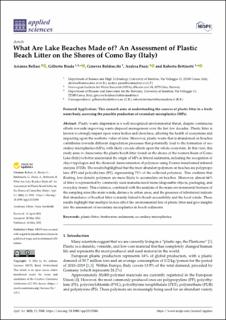| dc.description.abstract | Plastic waste dispersion is a well-recognized environmental threat, despite continuous efforts towards improving waste disposal management over the last few decades. Plastic litter is known to strongly impact upon water bodies and shorelines, affecting the health of ecosystems and impacting upon the aesthetic value of sites. Moreover, plastic waste that is abandoned on beaches contributes towards different degradation processes that potentially lead to the formation of secondary microplastics (MPs), with likely cascade effects upon the whole ecosystem. In this view, this study aims to characterize the plastic beach litter found on the shores of the western basin of Como Lake (Italy) to better understand the origin of MPs in littoral sediments, including the recognition of object typologies and the chemical characterization of polymers using Fourier-transformed infrared analysis (FTIR). The results highlighted that the most abundant polymers on beaches are polypropylene (PP) and polyethylene (PE), representing 73% of the collected polymers. This confirms that floating, low-density polymers are more likely to accumulate on beaches. Moreover, almost 66% of litter is represented by commonly used manufactured items (disposable objects, packaging, and everyday items). This evidence, combined with the analysis of the main environmental features of the sampling sites (the main winds, distance to urban areas, and the presence of tributaries) indicate that abundance of beached litter is mainly linked to beach accessibility and the local winds. These results highlight that multiple factors affect the environmental fate of plastic litter and give insights into the assessment of secondary microplastics in beach sediments. | en_US |

